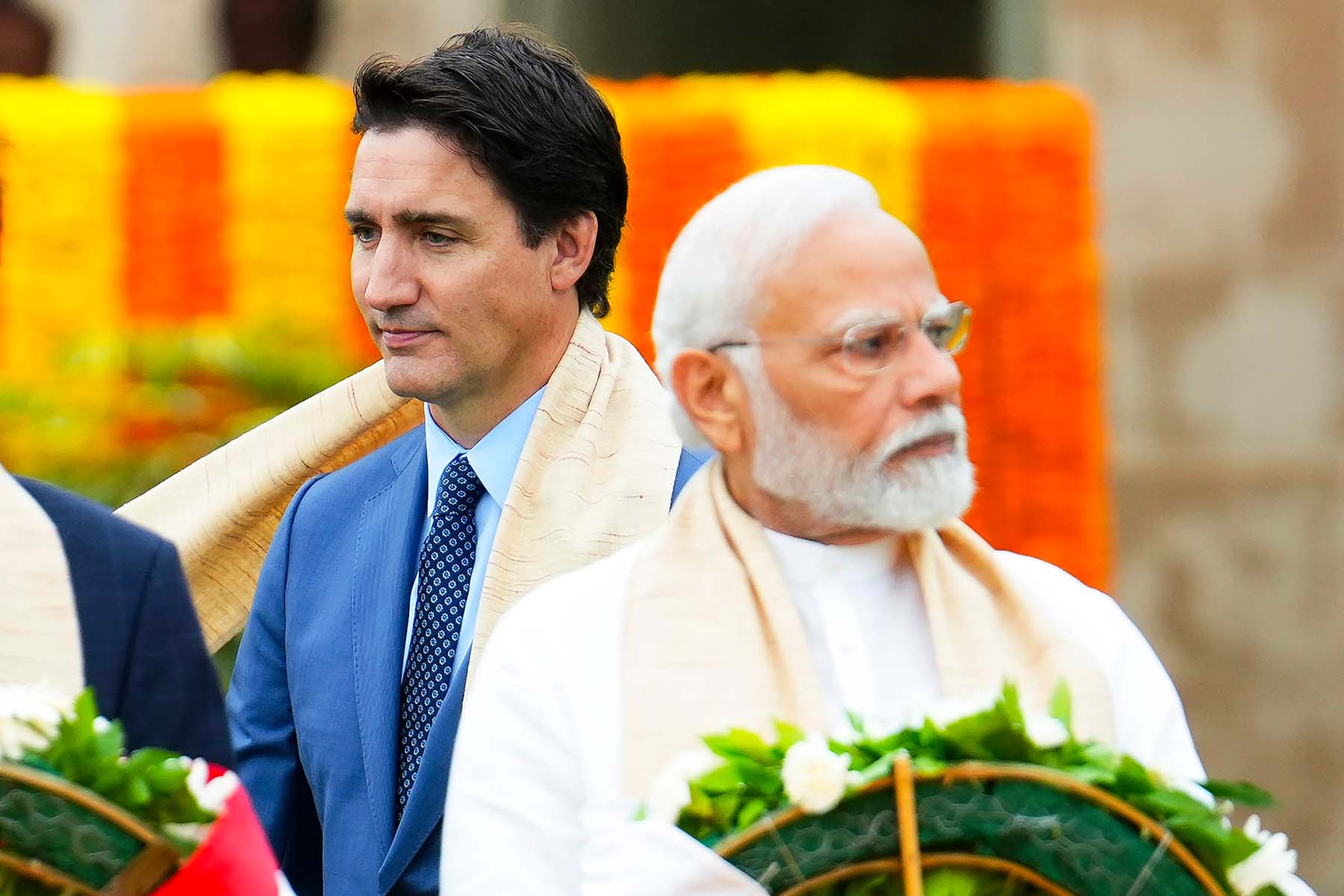Last November, when Manhattan prosecutors named an Indian citizen, Nikhil Gupta, in a foiled plot to assassinate a Sikh separatist leader in New York, they provided chilling new details on an unfolding sordid drama involving at least three countries—Canada, India, and the United States. The indictment revealed that Gupta, allegedly a drug trafficker, had been hired by an official inside the Indian government (unnamed co-conspirator, CC-1). CC-1 directed Gupta to hire an assassin to take out the New York–based lawyer who we now know—he has been identified by US officials in various media reports—was Gurpatwant Singh Pannun, a voluble supporter of carving a separate sovereign Sikh state of Khalistan out of India. The US officials had access to private text messages between CC-1 and Gupta which gave them full visibility into a larger plot to kill at least four Sikh separatist leaders in North America—a plot that first became public with the attack that did succeed: the killing of separatist leader Hardeep Singh Nijjar in Surrey, BC, last June.
The fifteen-page Department of Justice document, unsealed in a New York district court, also provided new details on Nijjar’s fatal shooting. Just hours after the forty-five-year-old’s murder, CC-1 sent a video of the bloodied body, along with Pannun’s New York address, to Gupta. As per the indictment, two days later, CC-1 sent Gupta a news article about Pannun and told him Pannun’s killing was a “priority now.” (Nijjar, who organized referendums in Canada in support of Khalistan, was an associate of Pannun’s. The two had travelled together to Geneva to petition the United Nations to recognize the killings of Sikhs in India in 1984, in the aftermath of the assassination of then prime minister Indira Gandhi, as a genocide.) Nijjar’s murder outside a Sikh temple in Surrey turned into a diplomatic spat in September, when Prime Minister Justin Trudeau claimed on the floor of Parliament there were “credible allegations” that the Indian government had been involved in the killing. The Canadian government asked an Indian intelligence official, Pavan Kumar Rai, officially accredited as a diplomat at the Indian high commission in Ottawa, to leave the country, leading to retaliatory actions against Canada by the Indian government headed by Prime Minister Narendra Modi.
Top American officials, including President Joe Biden at the G20 summit in New Delhi in September, had personally raised the matter of Pannun’s attempted murder with their Indian counterparts well before Trudeau delivered his statement in Parliament. But Modi’s government dismissed the Canadian claim as “absurd,” repeatedly accusing Canada instead of becoming “a safe haven for terrorists.” The Indian side argued that the Canadian side had not revealed any evidence to back its claims; the sealed US DoJ indictment could be the reason for the Canadian reticence. Ottawa perhaps had access to the same evidence that was submitted in the court; revealing it to India may have jeopardized the legal process in the US. The US indictment added weight to Trudeau’s claims, but the Indian government still refused to take Canada’s allegations seriously. “Insofar as Canada is concerned, they have consistently given space to anti-India extremists and violence. That is at the heart of the issue,” the official Indian foreign ministry spokesperson said, blaming Canada for “interference in our internal affairs,” which “is obviously unacceptable.”
Unlike in Canada’s case, however, India promptly said it would co-operate with the United States in the probe into the foiled plot to kill Pannun. In an interview with the Financial Times in December, Modi said “if a citizen of ours has done anything good or bad, we are ready to look into it. Our commitment is to the rule of law.” Outgoing Canadian national security adviser Jody Thomas told CTV in January that India was now co-operating and “they’ve moved things forward.” When asked if Canada’s improved relationship with India was a result of the US indictment, she said that “the two are connected for sure.” She asserted that the information revealed by the US “supported our position and our assertions with India. India is working with us, and my counterpart, in particular, far more closely to resolve this.”
Days later, Indian foreign minister S. Jaishankar went back to his old argument that “separatism, extremism, and violence have been given space in Canada’s politics.” In an interview with NDTV, he claimed that Canada “did not share anything but made allegations in public. In comparison, see the example of the US. The US told us that they have some information about criminals, and they will give us some information to look into from our side, and we will compare the information, investigate the matter.” Indian high commissioner to Canada Sanjay Kumar Verma reiterated that Canada had not shown India anything that tied Nijjar’s killing to India, which he said was a condition of New Delhi’s co-operation.
Meanwhile, the Surrey RCMP said in February that they were investigating an overnight shooting at a home belonging to Simranjeet Singh, a friend of Nijjar’s. The shooting came a few days after he helped organize a pro-Khalistan protest at the Indian consulate in Vancouver on January 26. Canadian allegations about Indian interference are also echoed by Pakistan, which blames India’s external intelligence agency, the Research and Analysis Wing, or R&AW, for planning assassinations targeting Sikh and Kashmiri activists living in foreign countries, including inside Pakistan. Research by an American academic, Christopher Clary, and researcher Uzair Sattar shows “eleven credible allegations,” aside from the foiled Pannun plot, “of targeted killings of anti-India terrorists, militants, or activists in the past two years.” Moreover, in a recent article in The Print, a retired lieutenant general of the Indian Army described witnessing a fellow senior retired officer “read out a list of persons who were neutralised by the Modi government to an audience of students in one of India’s most hallowed institutions.” All of this adds credence to suggestions of the existence of an official Indian programme to eliminate its adversaries based in foreign lands.
Although the existence of such a programme is unlikely to be confirmed by New Delhi, the presumption cannot be ignored when one considers statements made by Modi and his top security officials over the past decade, including before they assumed office. Foremost among them is a speech by Ajit Kumar Doval, India’s national security adviser, shortly before he took office under Modi in May 2014. A former head of India’s domestic intelligence agency, the Intelligence Bureau, with a penchant for covert field operations, Doval is the only senior security official to remain unchanged in his post since Modi became prime minister. Now seventy-nine, he earned a reputation, and India’s second highest gallantry award, the Kirti Chakra, in the 1980s for intelligence operations targeting the violent Khalistan secessionist movement when it was at its peak in the Sikh-majority Punjab state. Khalistan is the name of the proposed separate Sikh nation as envisioned by some Sikhs, incorporating the Indian state of Punjab as well as other Punjabi-speaking areas of northern India. The violent ethno-religious movement gained traction in the 1970s and early ’80s and was subsequently subdued by the Indian state, but Khalistan remains a goal for a section of the Sikh diaspora.
In a 2012 essay, Doval made a case for Indian intelligence to develop “proactive and interventionist operational actions.” In a lecture delivered in February 2014, he argued that India’s counterterror strategy needed to move from a defensive mode to “defensive-offense” mode. “To defend ourselves, we will go to the place from where the offense is coming,” he explained. Doval also advocated a “paradigm shift” by responding to terror groups through “intelligence driven operations.”
With Modi as prime minister, powers of strategic decision making shifted away from the defence and foreign ministries and came to be concentrated in the Prime Minister’s Office, where the National Security Council Secretariat, run by Doval, is situated. Under Doval, the NSCS has expanded considerably, with a substantial increase in its budgetary allocations; his powers have been enhanced and formally included in the government rules of business. In 2019, his status was upgraded from that of a minister of state, a junior rank, to that of a cabinet minister. He formulates and runs India’s China policy, conducts back-channel talks with Pakistan, handles Afghanistan, and oversees the work of all the Indian intelligence agencies, particularly the R&AW.
Jaishankar, India’s foreign minister, is the diplomatic face of Modi’s government, but his role is more that of a spokesperson, who is often seen making the case for the Hindu nationalist government’s policies and actions in foreign capitals, than that of a top decision maker. A political lightweight, the former diplomat was brought into politics by Modi and seems to carry little heft within the system. This imbalance in power between Doval and Jaishankar means that Modi’s government increasingly sees its foreign policy challenges through the prism of security and intelligence rather than diplomacy.
Underpinned by three distinct strands visible in the ethos of India’s current political dispensation—a great-power aspiration and the delusion that the country has arrived on the world stage; the extreme version of the Hindu nationalist ideological dictum of displaying strength by employing violence; and the belief that, to counter China, the West needs India more than Delhi needs the Western powers—this imbalance leads to risky decisions and dangerous actions. India and Pakistan came close to a nuclear exchange in early 2019, as per then US secretary of state Mike Pompeo, when Modi’s government decided to send Indian fighter jets to bomb a seminary in Balakot, inside Pakistan, because it supposedly harboured terrorists.
The unsealed DoJ indictment only provides more evidence of the reckless attitude and belligerent approach of the Modi government in the conduct of its foreign policy. The Indian leadership suffers from a euphoria of power. And its effects are now showing on a global level. India runs the risk of being clubbed with authoritarian regimes like Russia, China, and Iran, which punish, kidnap, or assassinate critics, activists, dissidents, and journalists in foreign countries. Modi is fond of claiming India as the “mother of democracy,” but under him, India is now involved in one of the most egregious recent examples of what has been described as “transnational repression.”
The chain of events that led to the assassination plots in the US and Canada coincided with a massive farmers’ movement against three farm laws proposed by Modi’s government in 2020. Thousands of farmers, led by the Sikh farmers of Punjab, who were emotionally and materially supported by the Sikh diaspora in Western countries like the UK, the US, and Canada, laid siege to India’s national capital for months. Because of their historical experience of the Khalistan movement, the top echelons of India’s current security and intelligence establishment suffer from a serious Khalistan itch. There was a concerted attempt by the political establishment to discredit the farmers’ movement by portraying it as part of the Khalistan project. Various agencies of the Indian state also became active around that time to designate Nijjar, Pannun, and others as individual terrorists. Another case was filed against Pannun following the farmers’ protest, but India’s foreign ministry has refused to clarify whether it has made a formal request for his extradition from the US. Other government agencies also got involved, setting in motion a process that was to reveal itself in the DoJ indictment.
Fingers point to the likely role of the R&AW, which doesn’t come under any parliamentary or legal oversight. A Bloomberg Businessweek report revealed that Indian personnel are rarely used in the agency’s most sensitive overseas operations. Instead, for plausible deniability, the R&AW tends to contract out the work to local actors who can be shown to have had a personal grudge against the targeted person. There is no formal process for authorizing such actions; it is a grey area left to the discretion of the head of the R&AW. It is influenced by his tolerance for risk as well as his sense of how much political backing he might receive. He may consult with the NSA, in this case Doval, but be careful enough to ensure that the activities are “deniable.” Ward Elcock, former head of the Canadian Security Intelligence Service, has said that the R&AW “has a reputation for being cowboys at the best of times” and the Canada episode demonstrated that they “weren’t very good at what they did.”
From June 2019, the R&AW was headed by Samant Kumar Goel, a Punjab cadre police officer who fought Khalistan militancy in his younger days. He was the head of the intelligence agency during the farmers’ movement, when it was involved in monitoring external support for the agitating farmers. Previously during his tenure, British intelligence had voiced unhappiness on several occasions over the increasing involvement of the R&AW in Sikh diaspora politics in the UK. Earlier, in 2012, as head of the R&AW’s London station, Goel was caught in a major controversy when British intelligence agencies claimed that he was seeking to recruit Khalistan-linked figures already in their service. Goel’s tenure as R&AW chief was to end in June 2021 but was first extended by a year and subsequently by another year. He finally retired on June 30, 2023.
On June 20, as per the unsealed indictment, CC-1 messaged Gupta, “It’s priority now.” Shortly thereafter, Gupta told “CS,” who later turned out to be an undercover US agent, on an audio call to “find the opportunity” to carry out the Pannun killing and to “do it quickly.” He added, “Before the 29th [June] we have to finish four jobs”—one in New York and three others in Canada. This was a reversal of the earlier direction, when CC-1 was concerned about the geopolitical fallout of killing a high-profile Sikh separatist during Modi’s state visit to the US. It has been speculated that the urgency was triggered by the announcement that a change of guard at the R&AW would take place on June 30. This urgency also forced the DoJ to act quickly to have Gupta arrested in Prague and thwart the plot. By then, there was already a worry that multiple hit teams may have been on the loose in North America, and one had already been able to evade detection and carry out its mission to kill Nijjar in Surrey.
The R&AW’s tryst with Sikh separatists in the West has been grabbing attention for a few years now. Since 2015, a year after Modi became prime minister, the agency has been aggressively trying to recruit agents inside pro-Khalistan circles across Europe and Canada and infiltrate those cells. In Germany alone, five individuals have been prosecuted in relation to R&AW operations. In 2020, Germany ordered India to withdraw one intelligence operative working for the R&AW in Frankfurt. It led to the conviction of Balvir Singh, who was given one year in prison and a €2,400 fine for allegedly spying on Khalistan supporters in the city. Earlier, a Frankfurt court gave Manmohan Singh, a journalist running a pro-Khalistan online news platform in Germany, an eighteen-month sentence for spying on Kashmiri and Sikh separatists for the R&AW’s Frankfurt station. Along with his wife, Kamaljit Kaur, he was found guilty of receiving €7,000 for information provided to the R&AW between 2015 and 2018. In 2015, a German immigration officer working in North Rhine-Westphalia was prosecuted for accessing government databases to sell information on suspected Khalistan activists to the R&AW. The previous year, Ranjit Singh, who had sought asylum in Germany claiming to be a Sikh separatist persecuted by India, was sentenced to nine months in prison for spying for the R&AW. In Canada, too, court documents show that immigration authorities denied an Indian journalist permission to join his family there, saying he had sought to influence politicians in that country on instructions from the R&AW. The immigration authorities’ determination was overruled by a court in March 2020.
Things have not improved for the R&AW in recent months. Two senior officials were asked to leave their stations in San Francisco and in London around the time the Pannun murder plot was being reeled in by US agencies. The R&AW was blocked by the US from replacing its station head in Washington, DC, a post that has been vacant since last year. Unnamed Indian government officials claim that none of this has to do with Western pressure but only administrative reasons caused by the change of leadership at the R&AW, which, devoid of any parliamentary or legal scrutiny, operates directly under the top political executive: Prime Minister Modi and NSA Doval. That’s where the buck stops.
India’s response to the allegations made by the US has been remarkably different from its reaction to Trudeau’s charges. While the Indian government promised a “high-level enquiry committee to look into all aspects” of the Pannun murder plot, it continues with the verbal tirade against Canada. In an interview with the Canadian Press in December last year, Trudeau said, “They chose to attack us and undermine us with a scale of misinformation and disinformation in their media that was comical. (It) would have been more comical had it not had real implications for peoples’ lives and relations between our two countries that are so deep in terms of people to people ties, and people depending on the flow of connections between us.” Addressing why he went public in September with the allegation of India’s involvement in Nijjar’s killing, he said, “We felt that all the quiet diplomacy and all the measures that we put in . . . needed a further level of deterrence, perhaps of saying publicly and loudly that we know, or we have credible reasons to believe, that the Indian government was behind this. And therefore put a chill on them continuing or considering doing anything like this.”
The committee announced by India in response to the Pannun murder plot could be an effort by the government to show intent, buy time, and wait for the storm to blow over. But it reflects the difference in power wielded by the two North American neighbours—or at least how Modi’s government perceives it.
In a statement indirectly referring to India, the US Department of State has said, “We have made clear that we oppose transnational oppression no matter where it occurs or who might be conducting it. That’s not a comment specific to India. That’s a comment specific to any country in the world.” Senator Ben Cardin, who chairs the pivotal US Senate Foreign Relations Committee, placed a hold on a proposed agreement of the Biden administration to sell Predator B Sea Guardian drones to India, raising “concerns regarding the timing of this sale to administration officials in light of the alleged murder-for-hire plot involving Indian officials to attempt to assassinate an American citizen on U.S. soil.” He released the hold only after he was assured by the Biden administration that “the Indian government is committed to thoroughly investigating the situation and fully cooperating with the U.S. Department of Justice investigation so that there is credible accountability in this case.” Cardin had also spoken about the issue during Congressional hearings on transnational repression last December.
India cannot afford to displease the US, not only for strategic reasons like countering China or for getting advanced defence technology but because it also needs the US administration to impress the domestic Indian audience by having the American president in New Delhi hugging Modi and singing meaningless paeans to India’s global leadership. Modi invited Biden, unsuccessfully, to be the chief guest for India’s Republic Day function in January, as was successfully done with President Barack Obama in 2015. Modi had also hosted an election rally for President Donald Trump in his hometown of Ahmedabad in 2020. The US has good reason to forge closer ties with India, a populous and big country that is a valuable counterweight to China in Asia and the Indo-Pacific, and India’s calculations are based on its critical value to these American designs.
With the DoJ chargesheet clearly linking the Indian government official CC-1 and Gupta to Nijjar’s murder, the Indian response to Canada now sounds like all bluff and bluster. As Trudeau said, “The news coming out of the United States further underscores what we’ve been talking about from the very beginning, which is that India needs to take this seriously.” Much depends on how India now responds to the indictment. The same indictment has brought the functioning of the R&AW under increasing scrutiny, but limiting the examination only to its functioning overlooks the wider political environment under the current dispensation in India that has promoted and empowered this behaviour. Unless the structural factors change, we should expect more unforeseen provocations and risky gambits in India’s ties with other countries, particularly those with a large Indian diaspora like Canada.




